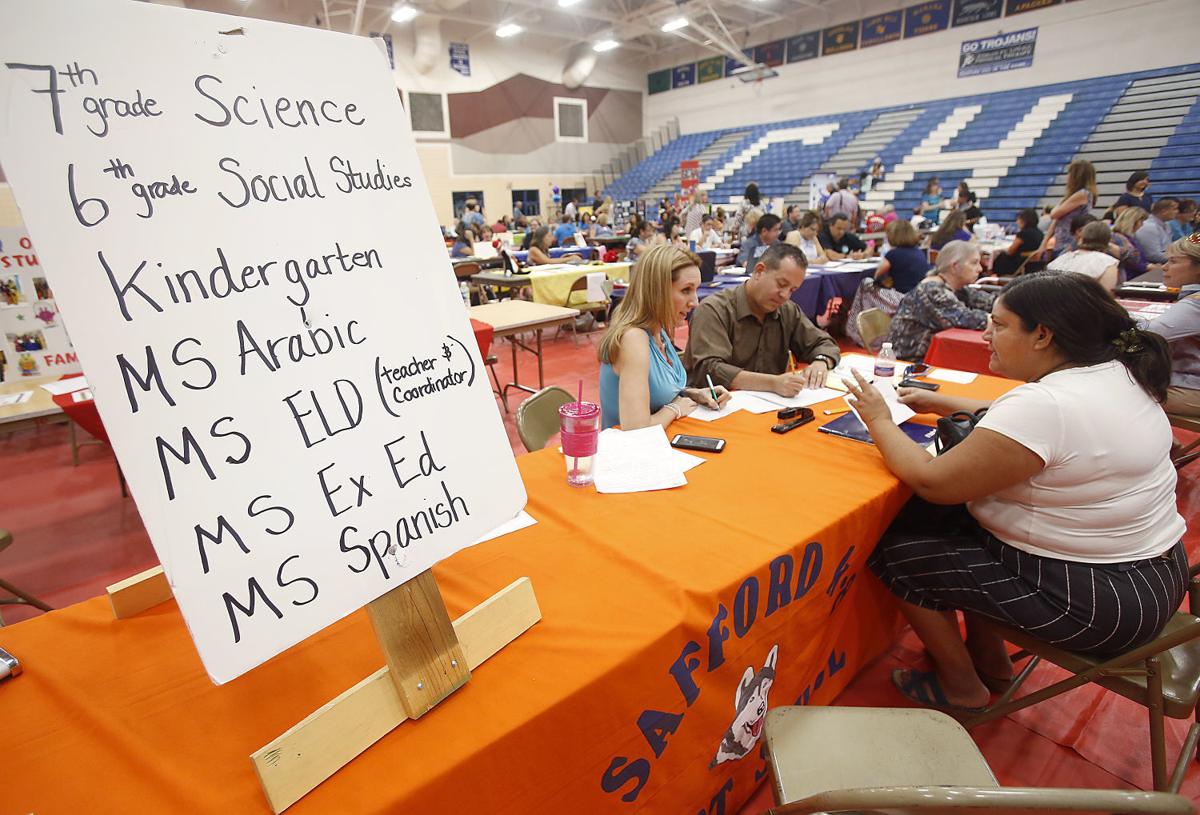Nearly one in four teaching vacancies that Arizona school districts had this year remains unfilled four weeks into the academic year.
The 178 school districts and charter schools that responded to a survey reported they needed to fill 6,227 slots this school year, says a new report by the Arizona School Personnel Administrators Association.
Districts have tried to make up the difference by putting people who do not meet standard teaching requirements in front of classrooms. These include people who are in a teacher intern program or have emergency teaching certificates or lack training in how to teach but have a professional background in a subject such as math or physics.
Those are not long-term solutions, however, as the emergency certificates are valid for just one year and available only three times to any individual.
Other slots were filled by those whose certification has not yet been approved.
All of those alternative methods managed to produce nearly 2,980 people in classrooms.
Yet schools reported they still have 1,547 positions where there are no teachers to be had.
The largest share of these vacancies are being “filled” with long-term substitutes. But schools have also gotten existing teachers to take on additional classes, put more children into classes than districts determine is suitable, and created multi-grade classrooms.
Complicating the problem, according to the report, is that 300 teachers have already resigned this year, an additional 109 didn’t report to work on the first day of school and 54 simply abandoned their jobs.
There is one bright spot in comparison with the three prior years the survey has been conducted, said Justin Wing, the association’s immediate past president:
The number of vacancies that had to be filled at the beginning of the academic year was down, at 6,227, from the nearly 7,000 at the same time last year.
Money is likely the reason, Wing said. Legislation approved earlier this year provided funding for the equivalent of an immediate 9 percent increase in teacher salaries.
The exact amount each teacher got varies, with decisions on how to divide the cash left to individual school boards. Some districts provided across-the-board increases; others front-loaded starting salaries to attract more teachers, or came up with different formulas.
The survey showed the salary boost improved year-over-year retention, Wing said.
At his own Washington Elementary School District in Phoenix, for example, “I had teachers who planned on retiring at the end of the year going, ‘Wait a minute. Never mind,’” he said.
Still, those teachers eventually will retire. Wing said it remains to be seen whether the salary increase — including a pair of 5 percent pay raises in each of the next two years — is enough to turn the shortage around.
Recruiting more teachers through higher salaries will take time, Wing said.
“It takes four years before you graduate with a College of Ed degree,” he noted.
There’s also the question of whether salaries alone are enough to attract more to the profession. He said there has been a decline in the number of students seeking education degrees at Arizona universities.
Only if there is a boost in enrollment, Wing said, will state officials know that they’re doing what’s necessary to deal with the perennial shortage of qualified teachers. Even then, he said, success will be measured by whether there is competition among applicants for available jobs.
“Just like any business, you have an opening, you don’t want one applicant,” Wing said. “You want multiple applicants if you want to hire the best fit, the best quality individuals.”
State Superintendent of Public Instruction Diane Douglas said the latest numbers are not a surprise.
“Unfortunately, the results of this annual survey again underscore the struggles our schools are facing as a result of the continuing teacher shortage in Arizona,” she said.
Douglas, who advocated for pay raises long before Gov. Doug Ducey came up with his plan, said money is only part of the solution. She said the state needs other ways to attract people to the profession.
One of those, she said, is the Troops to Teachers program that helps current and former members of the military begin careers in education. Douglas’ agency got a $735,000 grant earlier this year to staff that program.
Douglas also said a new online certification portal will help reduce delays in getting teachers the proper paperwork to enter the classroom.
Gubernatorial press aide Daniel Ruiz cited the improvement in teacher retention rates as proof that Ducey’s programs, including the pay hike, are working.
As to the issue of getting more people into the profession at the front end, he said the governor has promoted a “teaching academy” that gives some education students free tuition, as well as alternate pathways into the classroom besides traditional university teacher-training programs.
Wing said there are issues beyond pay that deter people from going into teaching or staying in the profession. But there, too, money is an issue. An example is class size. Recent studies showed Arizona has more students per teacher than just about any other state.
But, as Wing said, that is unlikely to improve until there are more people willing to enter the profession — and stay there.





